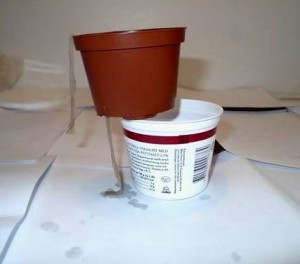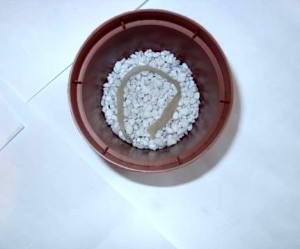The wick watering system
 The wick watering system is an ideal system for those who collect African violets and have more than 30 specimens in their collection.
The wick watering system is an ideal system for those who collect African violets and have more than 30 specimens in their collection.
It's a pretty practical system, which allows saving time. Young African violets develop faster and bloom much earlier ( third or fourth month) than the wet ones in the saucer (the fifth or sixth month). Nutrients and water reach the roots of the plant evenly, and through the potted soil the air circulates easily for a long time.
Materials needed for the wick watering system:
Optimal and basic condition for a harmonious development of the root system of the plant (obviously and the plant) consists of the perfect combination of three components: Water, air and the mixture of earth.
In the watering system with wick are used permeable materials and which retain moisture well. The perfect materials for this type of system and used in equal proportions, Are: pearlite, vermiculite and peat mixture for indoor plants.
Before being used, perliteul and vermiculitul will get wet with water. The mixture should be wet, do not wet.
For the manufacture of the wick fits any synthetic material. By wick, due to the capillary force of the plant, the water will be lifted from the 'tank' under the pot. The important thing is that it does not rot and easily absorbs moisture.
The material chosen for the manufacture of the wick, before being used it will get wet and let it dry. After that, put in a glass of water. If it got wet quickly – it's perfect for the fuse, if it floats on top without having absorbed a little water – look for another material.
The perfect material for making the wick are women's stockings. Cut strips of length 20-25 cm and width 7-8 mm. Before being placed in the pot, they will get wet.
As a tank can be used any container. Ideal are plastic cups from sour cream or yogurt. In their lid is made a hole where the wick will be inserted, and above the lid is placed the pot with the plant.
Pots with chicks can be placed on a common tank, made of larger plastic boxes in which the pastry products are usually kept.
How to plant the plant on the wick?
Before being transplanted the plant will get wet, that during planting the soil to be wet.
Prepare a new mixture of earth, mixing very well all the components. The holes on the bottom of the pot will be covered with pieces of penoplast. In one of the holes will be inserted the moistened wick, leaving outside an end of 8-10 cm long. The length of the end depends on the depth of the chosen tank.
Holding with his hand the inside of the wick, on the bottom of the pot sits a layer of pearlite or from the soil mixture of thickness 1.5-2 cm, and the wick sits in the shape of a ring on the surface of this layer.
If a mature plant is planted in the pot, the pot will be filled with soil mixture up to 2/3 of its height, if you will plant a flower chicken, the pot will fill with soil.
The mature plant will be removed from the old pot, it will removal from the roots as much as possible the old soil, without injuring the root. The roots will not be washed, because there is a possibility that they rot.
removal from the roots as much as possible the old soil, without injuring the root. The roots will not be washed, because there is a possibility that they rot.
African violet is planted accurately in the prepared pot, distribute the roots on the surface of the earth mixture. Holding with one hand the plant, the soil mixture is poured over the roots, until we fill the pot.
The pot is placed on the tank and the wick is passed through the hole in the lid.
The plant gets wet on top, without the water reaching directly to the roots. Water must drain through the wick into the tank.
The plant sits where it belongs and after a few days it will also fill the tank with water. In the water in the tank you can also put the necessary nutrients for the plant especially during the rest period after an abundant flowering.
The filling frequency of the tank depends on its volume, plant dimensions, humidity and air temperature in the room, the intensity of the air currents around the plant.
Under normal conditions, a tank with a volume of 250 ml will be filled at an interval of 7-8 days in the case of a mature plant, in the case of chickens somewhat less often.
If at the next filling in the tank is left  a little water, it is thrown away, wash the tank and fill it with water prepared for watering.
a little water, it is thrown away, wash the tank and fill it with water prepared for watering.
If the water is no longer in the rezrvor and the wick is dry, the plant will get wet from above, until the water will trickle into the tank by means of the wick.
If a whitish sediment is observed above the ground, the plant will get wet from above, letting the water drain into the sink. In this way the soil will wash away from excess salts that can harm the plant.
If the growth point of the plant, especially of purple chickens, is abundantly hydrated and is covered with a red-brown sediment, the plant will be taken from the tank and a few weeks will get wet from the plate, leaving to dry the layer of earth on the surface between waterings. When the plant will recover and new leaves will appear, it will get wet again through the wick.
Of course, watering by wick is not a saving solution for many collectors of African violets. In everyone's house there are different conditions and not for all this solution proves to be a perfect one.
It's worth trying it. For starters, go to watering by wick just a few less valuable copies of your collection. Perhaps this method of watering will be much more effective than the usual one and you will be able to grow beautiful specimens with fewer wastes of time and effort.

